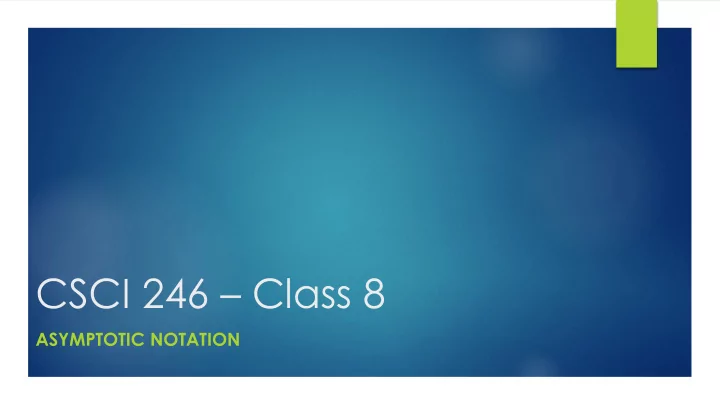

CSCI 246 – Class 8 ASYMPTOTIC NOTATION
Quiz Questions Lecture 14: What is the Big- O notation for Euclid’s Algorithm runtime? Lecture 15: Show f(n) = 10n + 5 is in O(n 2 )
Notes Modified Office Hours Today Midterm Homework Handback
Lesson 14 & 15 Big – O => Upper Bound
Lesson 14 & 15 Big – O => Upper Bound f(n) = O(g(n)) if there exist positive constants c and n 0 such that f(n) <= c*g(n) for all n >= n 0
Lesson 14 & 15 Big – O => Upper Bound f(n) = O(g(n)) if there exist positive constants c and n 0 such that f(n) <= c*g(n) for all n >= n 0 Example: (http://www.fas.harvard.edu/~cscie119/lectures/sorting.pdf ) f(n) = n 2 /2 – n/2 is O(n 2 ), because n 2 /2 – n/2 <= n 2 for all n >= 0
Lesson 14 & 15 Big – O => Upper Bound f(n) = O(g(n)) if there exist positive constants c and n 0 such that f(n) <= c*g(n) for all n >= n 0 Example: (http://www.fas.harvard.edu/~cscie119/lectures/sorting.pdf ) f(n) = n 2 /2 – n/2 is O(n 2 ), because n 2 /2 – n/2 <= n 2 for all n >= 0 n o =0 c=1
Lesson 14 & 15 Big – 𝛁 => Lower Bound f(n) = O(g(n)) if there exist positive constants c and n 0 such that f(n) <= c*g(n) for all n >= n 0
Lesson 14 & 15 Big – 𝛁 => Lower Bound f(n) = 𝛻 (g(n)) if there exist positive constants c and n 0 such that f(n) <= c*g(n) for all n >= n 0 Example: n 3 + 4n 2 = Ω(n 2 ) is 𝛁 O(n 2 ), because n 3 < n 3 + 4n 2 for all n > 0
Lesson 14 & 15 Big – 𝛁 => Lower Bound f(n) = 𝛻 (g(n)) if there exist positive constants c and n 0 such that f(n) <= c*g(n) for all n >= n 0 Example: n 3 + 4n 2 = Ω(n 2 ) is 𝛁 O(n 2 ), because n 3 < n 3 + 4n 2 for all n > 0 c=1 n o =0
Lesson 14 & 15 Big – 𝚰 => Tight Bound f(n) = 𝛪 (g(n)) if there exists constants c 1 , c 2 , c 3 and n o such that c 1 *g(n) <= f(n) <= c 2 * g(n) for all n > n 0
Lesson 14 & 15 Big – 𝚰 => Tight Bound f(n) = 𝛪 (g(n)) if there exists constants c 1 , c 2 , c 3 and n o such that c 1 *g(n) <= f(n) <= c 2 * g(n) for all n > n 0 Example: (http://www.fas.harvard.edu/~cscie119/lectures/sorting.pdf ) f(n) = n 2 /2 – n/2 is 𝛪 (n 2 ) because (1/4)* n 2 <= n 2 /2 – n/2 <= n 2 for all n >= 2
Lesson 14 & 15 Big – 𝚰 => Tight Bound f(n) = 𝛪 (g(n)) if there exists constants c 1 , c 2 , c 3 and n o such that c 1 *g(n) <= f(n) <= c 2 * g(n) for all n > n 0 Example: (http://www.fas.harvard.edu/~cscie119/lectures/sorting.pdf ) f(n) = n 2 /2 – n/2 is 𝛪 (n 2 ) because (1/4)* n 2 <= n 2 /2 – n/2 <= n 2 for all n >= 2 c 1 =1/4 c 2 =1 n o = 2
Lesson 14 & 15 http://bigocheatsheet.com/
Homework (Group) Determine whether each of these functions is O(x) by giving a C and n 0 value where appropriate f(x) = 10 1. f(x) = 3x+7 2. f(x) = x 2 +x+1 3. f(x) = 5 log x 4. f(x) = floor(x) 5. f(x) = ceiling(x) 6.
Homework (Individual) Explain the differences between Big-O, Big- Ω (Omega), and Big- Θ (Theta) 1. Explains what it means for a function to be O(1) instead of O(n) 2. Show that f(x) = (x + 5) log 2 (3x 2 + 7) is O(x log 2 x) 3. Hint: Remember that log(x k ) = k ⋅ log(x) a) Consider: f(x) = 15n 3 + n 2 + 4, 4. Express f(x) in Big - O notation a) Express f(x) in Big – Ω notation b) Express f(x) in Big – Θ notation c)
Recommend
More recommend